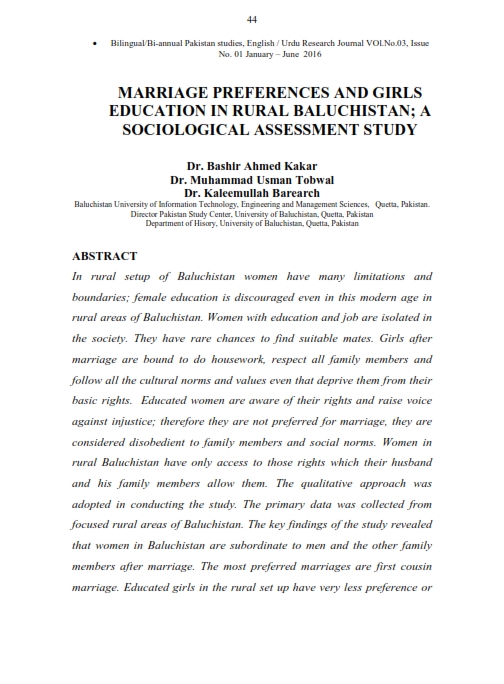MARRIAGE PREFERENCES AND GIRLS EDUCATION IN RURAL BALUCHISTAN; A SOCIOLOGICAL ASSESSMENT STUDY
Keywords:
Marriage Preferences; Girls Marriages; Girls Education; Marriage MarketAbstract
In rural setup of Baluchistan women have many limitations and
boundaries; female education is discouraged even in this modern age in
rural areas of Baluchistan. Women with education and job are isolated in
the society. They have rare chances to find suitable mates. Girls after
marriage are bound to do housework, respect all family members and
follow all the cultural norms and values even that deprive them from their
basic rights. Educated women are aware of their rights and raise voice
against injustice; therefore they are not preferred for marriage, they are
considered disobedient to family members and social norms. Women in
rural Baluchistan have only access to those rights which their husband
and his family members allow them. The qualitative approach was
adopted in conducting the study. The primary data was collected from
focused rural areas of Baluchistan. The key findings of the study revealed
that women in Baluchistan are subordinate to men and the other family
members after marriage. The most preferred marriages are first cousin
marriage. Educated girls in the rural set up have very less preference or
choice in their marriages. Marriage Proposals are given on the basis of
obedience to the family members and strict obedience of cultural values.
Girls and boys have no say in selecting mates. Boy’s family members only
send proposals to girl’s family for marriage.
References
admin. (13 7, 2015). Women life in rural Pakistan. Retrieved 15 12, 2015,
from The London Post: http://thelondonpost.net/women-life-in-ruralpakistan/
Gelain. (2013). Local Search Approaches in Stable Matching Problems.
Algorithms , 592.
Hoefer. (2012). Locally Stable Marriage with Strict Preferences?
Hussain, R. (1999). Community perceptions of reasons for preference for
consanguineous marriages in Pakistan. Journal of Biosocial Science , 449-
Jamal, A. (2014). Men’s Perception of Women’s Role and Girls’
Education among Pashtun Tribes of Pakistan. Cultural and Pedagogical
Inquiry , 17-34.
Look who’s on top of the marriage market. (n.d.). Retrieved 19 12, 2015,
from The Globe and Mail: http://www.theglobeandmail.com/globedebate/look-whos-on-top-of-the-marriage-market/article20698264/
Marriage. (2015). Encyclopedia Article .
Matthews. (2012). A Comment on Schoen's (1981) Harmonic Mean
Marriage Model. Mathematical Population Studies .
Naz. (2003). The status of female education in rural Balochistan. Impact:
Making a difference , 290-297.
Reneflot, A. (2006). A gender perspective on preferences for marriage
among cohabitating couples . DEMOGRAPHIC RESEARCH .
Rose, E. (2003). Does Education Really Disadvantage Women in the
Marriage Market? Center for Statistics and the Social Sciences University
of Washington .
UNESCO. (2015). EFA Globle Monitoring Report 2015. UNESCO.
Wikipedia, the free encyclopedia. (n.d.). Retrieved 18 11, 2015, from
Wikipedia, the free encyclopedia:
https://en.wikipedia.org/w/index.php?title=Marriage&oldid=696569919



